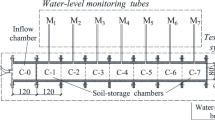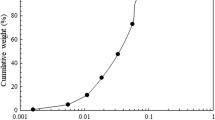Abstract
A knowledge of soil permeability is essential to evaluate hydrologic characteristics of soil, such as water storage and water movement, and soil permeability coefficient is an important parameter that reflects soil permeability. In order to confirm the acceptability of the one-dimensional horizontal infiltration method (one-D method) for simultaneously determining both the saturated and unsaturated permeability coefficients of loamy sand, we first measured the cumulative infiltration and the wetting front distance under various infiltration heads through a series of one-dimensional horizontal infiltration experiments, and then analyzed the relationships of the cumulative horizontal infiltration with the wetting front distance and the square root of infiltration time. We finally compared the permeability results from Gardner model based on the one-D method with the results from other two commonly-used methods (i.e., constant head method and van Genuchten model) to evaluate the acceptability and applicability of the one-D method. The results showed that there was a robust linear relationship between the cumulative horizontal infiltration and the wetting front distance, suggesting that it is more appropriate to take the soil moisture content after infiltration in the entire wetted zone as the average soil moisture content than as the saturated soil moisture content. The results also showed that there was a robust linear relationship between the cumulative horizontal infiltration and the square root of infiltration time, suggesting that the Philip infiltration formula can better reflect the characteristics of cumulative horizontal infiltration under different infiltration heads. The following two facts indicate that it is feasible to use the one-D method for simultaneously determining the saturated and unsaturated permeability coefficients of loamy sand. First, the saturated permeability coefficient (prescribed in the Gardner model) of loamy sand obtained from the one-D method well agreed with the value obtained from the constant head method. Second, the relationship of unsaturated permeability coefficient with soil water suction for loamy sand calculated using Gardner model based on the one-D method was nearly identical with the same relationship calculated using van Genuchten model.
Similar content being viewed by others
References
Ankeny M D, Ahmed M, Kaspar T C, et al. 1991. Simple field method for determining unsaturated hydraulic conductivity. Soil Science Society of America Journal, 55(2): 467–470.
Askarinejad A, Beck A, Casini F, et al. 2012. Unsaturated hydraulic conductivity of a silty sand with the instantaneous profile method. In: Mancuso C, Jommi C, D’Onza F. Unsaturated Soils: Research and Applications. Berlin: Springer, 215–220.
Baker F G, Veneman P L M, Bouma J. 1974. Limitations of the instantaneous profile method for field measurement of unsaturated hydraulic conductivity. Soil Science Society of America Journal, 38(6): 885–888.
Daliri F. 2011. A review of theoretical and experimental methods to measure coefficient of permeability of unsaturated soils. Electronic Journal of Geotechnical Engineering, 16: 1665–1677.
Elrick D E, Reynolds W D, Tan K A. 1989. Hydraulic conductivity measurements in the unsaturated zone using improved well analyses. Ground Water Monitoring & Remediation, 9(3): 184–193.
Elrick D E, Reynolds W D. 1992. Methods for analyzing constant-head well permeameter data. Soil Science Society of America Journal, 56(1): 320–323.
Fredlund D G, Rahardjo H. 1993. Soil Mechanics for Unsaturated Soils. New York: John Wiley & Sons Inc., 147–163.
Ganjidoost H, Mousavi J S, Soroush A. 2015. Adaptive network-based fuzzy inference systems coupled with genetic algorithms for predicting soil permeability coefficient. Neural Processing Letters, 44(1): 53–79.
Gardner W R. 1958. Some steady-state solutions of the unsaturated moisture flow equation with application to evaporation from a water table. Soil Science, 85(4): 228–232.
Green W H, Ampt G A. 1911. Studies on soil physics: I. Flow of air and water through soils. The Journal of Agricultural Science, 4(1): 1–24.
Hillel D. 1998. Environmental Soil Physics. San Diego: Academic Press, 173–201.
Houseworth J E, Leem J. 2009. A quasilinear model for solute transport under unsaturated flow. Vadose Zone Journal, 8(4): 1031–1037.
Jury W A, Gardner W R, Gardner W H. 1991. Soil Physics (5th ed.). New York: Wiley Publishers, 134–135.
Klute A. 1952. A numerical method for solving the flow equation for water in unsaturated materials. Soil Science, 73(2): 105–116.
Klute A, Dirksen. 1986. Hydraulic conductivity and diffusivity: Laboratory methods. In: Klute A. Methods of Soil Analysis, Part 1. Madison: Soil Science Society of America Inc., 687–734.
Lal R, Shukla M K. 2004. Principles of Soil Physics. New York: Marcel Dekker, 362–373.
Lu N, Likos W J. 2012. Unsaturated Soil Mechanics. Hoboken: John Wiley & Sons, 337–358.
Philip J R. 1957a. The theory of infiltration: 1. The infiltration equation and its solution. Soil Science, 83(5): 345–358.
Philip J R. 1957b. The theory of infiltration: 4. Sorptivity and algebraic infiltration equations. Soil Science, 84(3): 257–264.
Philip J R. 1969. Theory of infiltration. Advances in Hydroscience, 5: 215–296.
Philip J R, Knight J H, Waechter R T. 1989. Unsaturated seepage and subterranean holes: Conspectus, and exclusion problem for circular cylindrical cavities. Water Resources Research, 25(1): 16–28.
Radcliffe D E, Rasmussen T C. 2002. Soil water movement. In: Warrick A W. Soil Physics Companion. Boca Raton: CRC Press, 85–126.
Reynolds W D, Elrick D E. 1985. In situ measurement of field-saturated hydraulic conductivity, sorptivity, and the a-parameter using the Guelph permeameter. Soil Science, 140(4): 292–302.
Scherer T F, Seelig B, Franzen D. 1996. Soil, water and plant characteristics important to irrigation. In: North Dakota State University (NDSU) Extension Bulletin EB-66. Fargo: North Dakota State University.
Schiff L, Dreibelbis F R. 1949. Preliminary studies on soil permeability and its application. Eos, Transactions American Geophysical Union, 30(5): 759–766.
Scotter D R, Clothier B E, Harper E R. 1982. Measuring saturated hydraulic conductivity and sorptivity using twin rings. Australian Journal of Soil Research, 20(4): 295–304.
Shabani A, Sepaskhah A R. 2009. Determination of minimum soil clolmn length to determing soul hydraulic diffusivity function through a sample method. Iranian Journal of Soil and Water Research, 40(1): 35–42.
Shao M A, Horton R. 1998. Integral method for estimating soil hydraulic properties. Soil Science Society of America Journal, 62(3): 585–592.
Su P X. 2000. Research on soil dynamic constants of sandy land. Journal of Desert Research, 20(3): 329–332. (in Chinese)
van Genuchten M T. 1980. A closed-form equation for predicting the hydraulic conductivity of unsaturated soils. Soil Science Society of America Journal, 44(5): 892–898.
Wang Q, Tong L Y. 2014. Determination permeability coefficient from piezocone. Advances in Materials Science and Engineering, 2014: 396428, doi: 10.1155/2014/396428.
Wang Q J, Horton R, Shao M A. 2002. Horizontal infiltration method for determining Brooks-Corey model parameters. Soil Science Society of America Journal, 66(6): 1733–1739.
Wang W Y, Zhang J F. 1990. Simultaneous determination of water movement parameters of unsaturated soil in a horizontal soil column. Journal of Hydraulic Engineering, 7): 26–30. (in Chinese)
Watson K K. 1966. An instantaneous profile method for determining the hydraulic conductivity of unsaturated porous materials. Water Resources Research, 2(4): 709–715.
Yang S X, Lei Z D. 1991. Hydraulic conductivity determination using horizontal column infiltration. Journal of Hydraulic Engineering, 5): 1–7. (in Chinese)
Zhang Z Y, Sa T T, Tie X Q, et al. 2013. Soil water infiltration and its affecting factors. Applied Mechanics and Materials, 353–356: 2983–2986.
Acknowledgments
This study was funded by the National Basic Research Program of China (2013CB429902) and the National Natural Science Foundation of China (U1303181, 41671032).
Author information
Authors and Affiliations
Corresponding author
Rights and permissions
About this article
Cite this article
Hu, S., Zhu, H. & Chen, Y. One-dimensional horizontal infiltration experiment for determining permeability coefficient of loamy sand. J. Arid Land 9, 27–37 (2017). https://doi.org/10.1007/s40333-016-0062-3
Received:
Revised:
Accepted:
Published:
Issue Date:
DOI: https://doi.org/10.1007/s40333-016-0062-3




